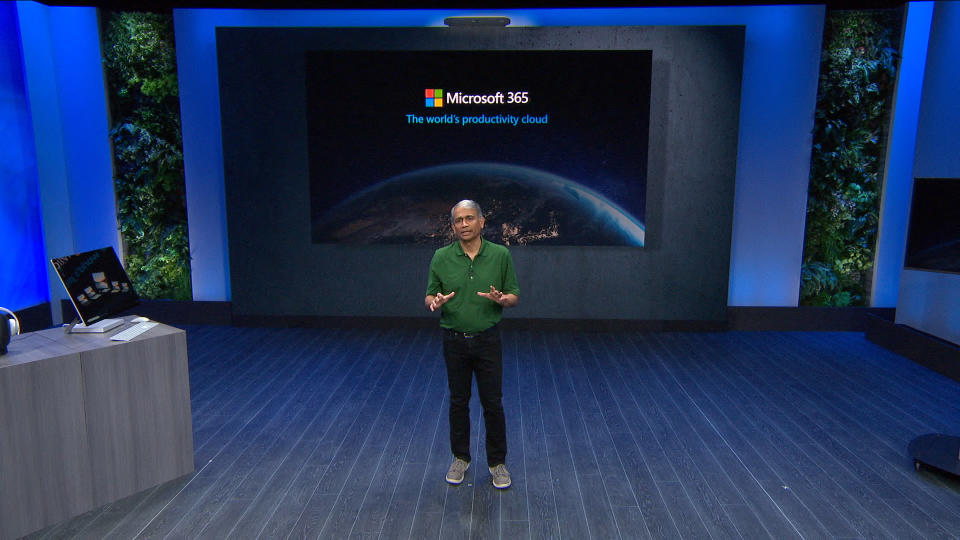Engadget has been testing and reviewing consumer tech since 2004. Our stories may include affiliate links; if you buy something through a link, we may earn a commission. Read more about how we evaluate products.
Microsoft flexed its cloud and AI muscles at Build 2020
Fluid Framework in particular could propel the company ahead of the competition.
This week Microsoft hosted its annual Build conference completely online. That meant streaming keynotes, panels, digital breakouts and workshops for developers. But that didn’t slow down the flow of news. From a new framework for Office collaboration and a Cloud offering for Healthcare to an AI supercomputer, Microsoft flexed some serious tech muscle. The company’s investments in cloud and machine learning are starting to deliver real products.
Businesses continue to be the main target of its software offerings -- things like Outlook, Office, Teams and SharePoint. Microsoft has been working to make its 365 services more powerful. It announced Fluid Framework last year, promising a collaboration ecosystem that does away with distinctions between Excel spreadsheets, Word documents and PowerPoint slides altogether. Those file types will cease to exist, and instead you’ll simply use bits and pieces of these formats in the same workspace. It’s a bold proposition, but one with the potential to propel Microsoft’s productivity software ahead of Google’s. At Build, the company announced it will be rolling out the Fluid Framework in the next few months.
If you’re on the Targeted Release cycle, you’ll be one of the first people to try this out in Office.com and Outlook for the web. In the new format, you’ll be able to start whichever Office app you want -- say Excel or Word, for example -- and pull in Fluid components like charts, tables or task lists.

These components will stay updated wherever they are, so if you edit a cell in a table you pulled from an existing spreadsheet, the value will save in every place it exists. You’ll also be able to collaborate on these files in real time with others, too. These components can be inserted into emails or even a chat app like Microsoft’s Teams. The company also announced that Fluid Framework will be open-source, so you might see third-party apps make use of these features in future too.
Microsoft also announced a new Lists app that’s based on the existing Lists feature in SharePoint. The project management tool will let you track your progress using checklists across Microsoft’s services, and you can create new to-do lists from within chat apps like Teams, too. You’ll also be able to import existing lists from elsewhere in the app for people in the room to comment and edit. Your coworkers can tweak or leave suggestions on both the full list and individual items in it as well. There’s also conditional formatting so you can have background or font colors change when items are checked off, or have the icons update based on specific situations.
As Microsoft continues to build out and enhance its suite of productivity software, it’s also eyeing ways to reach more organizations. This week, the company announced its first Industry Cloud offering, which is a set of tools designed for specific industries. Microsoft is starting with Cloud for Healthcare, which is pretty smart and timely given the country’s pivot to telehealth.

The new service offers medical workers access to a range of tools like Microsoft’s Teams and Healthcare Bot Service, in addition to patient engagement portals and systems for booking appointments and making referrals. Within Teams, health care providers can also conduct HIPAA-compliant telehealth visits and follow up on aftercare. The patient portals will also make it easier to manage appointment bookings, send reminders and make bill payments across various devices.
Providers can also use Cloud for Healthcare to reach out to patients with preventative and care management programs. With Azure IoT integration, they can also remotely receive data from medical devices in real time to escalate care when needed and respond quickly to emergency situations.
It all sounds like a comprehensive, well-rounded way to manage most of the aspects of running a health care business, which, given how fragmented America’s infrastructure is on this front, is welcome news.

From improving productivity software to creating cloud-based systems for entire industries, to … a supercomputer? Microsoft also announced that it’s developed a supercomputer hosted on its Azure cloud network. It was built specifically to train OpenAI models to tackle large problems. Microsoft hasn’t shared detailed speed measurements yet, but the supercomputer does have 285 THOUSAND CPU cores and 10,000 GPUs that help it execute massive, complicated AI models. That should make it one of the five fastest systems in the world.
While it’s not yet clear exactly what processes the supercomputer will work on, that amount of power could allow Microsoft to train AI for more complex tasks like moderating game streams, instead of simpler things like recognizing faces in photos, for example.
Again, Microsoft hasn’t laid out concrete plans for how it plans to use this supercomputer, but the company’s been public about its ambitions. It announced in April plans for a planetary computer that’s basically a system that takes in global data about the world, processes it with AI and machine learning, then delivers environmental and biological data to customers. The goal is to help inform decision-making around environmental issues in both the private and public sectors.
That’s a whole lot of news out of Microsoft in two days, and surprisingly, I’m excited about some of it. Fluid Framework is the most immediately compelling, since it could actually change my day to day workflow. Even though I’m currently a hardcore Google user, I could see Microsoft’s advancements spurring its rivals to step up their games. I’m also intrigued by Cloud for Healthcare and what it could do for medical workers and organizations everywhere.
This Build, Microsoft showed us improvements at the micro level with boosts to its productivity software, flexed its ample cloud muscle at the middle level with the Industry Cloud offerings, and finally, laid the foundation for good work to come at the macro level with its AI supercomputer news. It’s clear the company wants to be a part of your life at every turn.

 Yahoo Finance
Yahoo Finance 